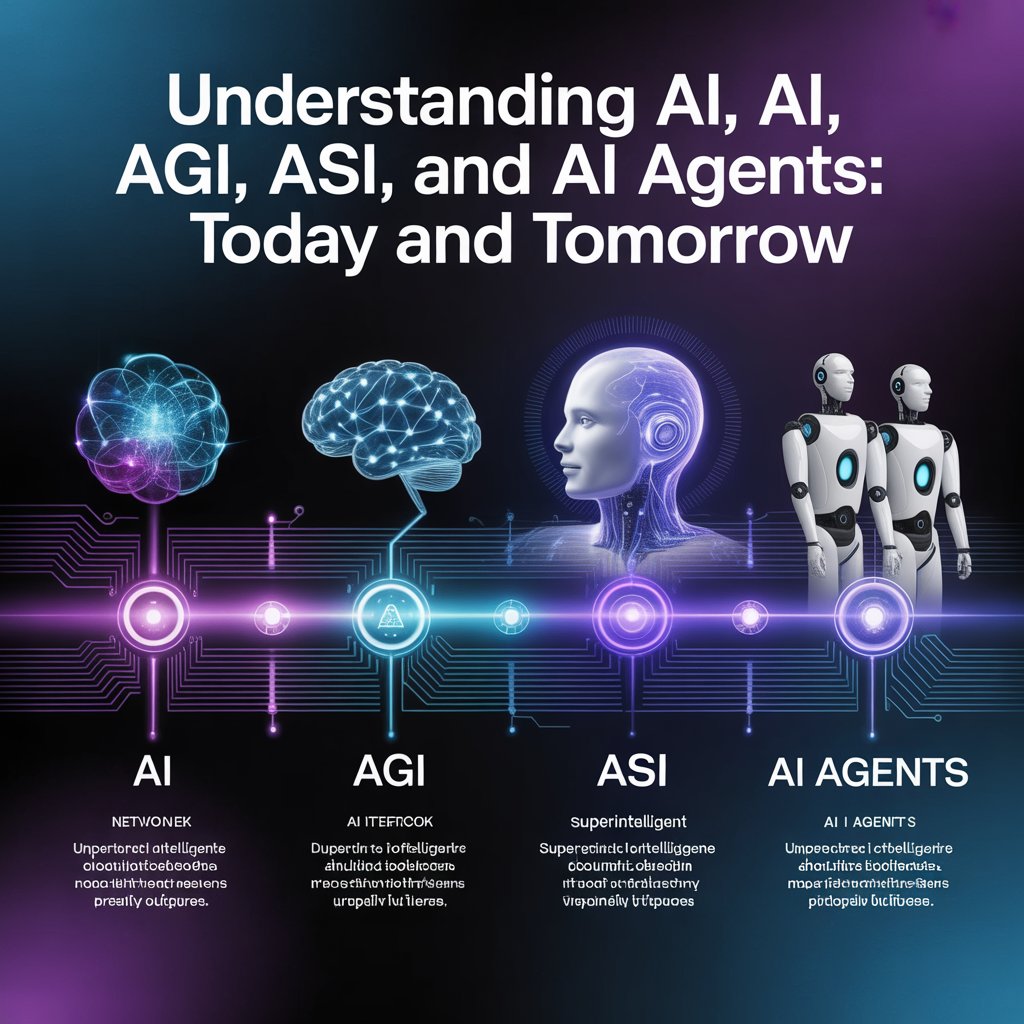Understanding AI, AGI, ASI, and AI Agents: Today and Tomorrow

The 21st century is the era of artificial intelligence (AI). AI is literally starting to become part of our lives and industry, from efficient voice assistants, recommendation systems to self-driving cars. But AI, ASI, AGI and AI Agents are the tip of a niceberg that features an entire spectrum of technologies and concepts. Understanding the distinction is crucial if you want to understand the future and present of intelligent systems.
Artificial Intelligence: The Present Reality
Artificial intelligence can be defined as the 76the design and construction of systems that, by building(’)t7 polymers human intelligence tasks. Such actions may include pattern recognition, understanding natural language, decision making and problem solving. (5) Today most AI systems are narrow or designed for a specific application.
Examples include:
- Recommendation engines ensured by Netflix and Amazon to recommend content or products.
- Chatbots similar to ChatGPT that is able to comprehend and reply to human inquiries.
- Computer vision systems for facial recognition or medical imaging.
- Autonomous driving technologies that help machines to move in the road without accidents.
These systems have tremendous power in a restricted domain, but they lack the general reasoning capacity that humans have. Not only will an AI playing chess not be able to drive a car, but also a language model will not be able to perform surgery. This limitation is a central dividing line between narrow AI and higher forms of intelligence.
Artificial General Intelligence (AGI): The Next Frontier
Artificial general intelligence or AGI is a form of AI that can perform anything that an ordinary human being can. Instead of narrow AI, a general-purpose AI would have general learning and reasoning. AGI would not simply be following the pre-programmed orders; it would think, plan and come up with solutions on its own in ways that are akin to human behavior.
Key characteristics of AGI include:
- Versatility: AGI is able to alternate tasks as human beings do.
- Learning from Experience: It is able to acquire new skills without being explicitly programmed.
- Common Sense Reasoning: AGI is able to perceive the world in a human-like way as well as drawing parallels between domains.
Although AGI is very theoretical, current studies in machine learning, neuroscience as well as cognitive computing are gradually improving towards this direction. Its implementation would transform such areas of human endeavor as scientific research, education, and healthcare and solve many complex problems more quickly than human specialists.
Artificial Superintelligence (ASI): Beyond Human Capability
Beyond AGI is Artificial Superintelligence, or ASI. ASI is a term used to describe an intelligence greater than human minds. This kind of AI wouldn’t just do things humans can do, only faster and more accurately it would perform tasks that are beyond our abilities and even exhibit creative thinking.
Potential attributes of ASI include:
- Superior problem-solving: ASI could develop new technologies or scientific theories that humans cannot comprehend.
- Self-improvement: It could recursively enhance its own intelligence, leading to rapid and exponential growth.
- Strategic thinking: ASI might optimize complex systems beyond human understanding, from climate modeling to global economics.
The emergence of ASI raises important moral, social and existential questions. How can we get human values to be aligned with ASI goals? What are the guardrails to prevent unintended consequences? These concerns have prompted debate at the global level among scientists, policy makers and ethicists about how to ensure AI is developed responsibly.
AI Agents: Acting in the World
Whereas expressions such as AI, AGI, ASI are used to describe the magnitude of intelligence, we refer to AI agents to denote intelligent beings (including Goal-Directed AI Agents) capable of acting within an environment, and that acting has the property or capability to bring about some goal state. The simplest AI agents are such objects as a programmable thermostat that you program to turn on and off every time the room becomes too hot or too cold, an autonomous drone that works out a route through a disaster area, etc.
One can observe that the AI agents possess the following characteristics:
- Perception: They feel and perceive the surrounding based on information given by sensors or other digital inputs.
- Decision making: They interpret information and know the most suitable course of action.
- Action: They act or make an impact on their surroundings depending on decisions.
- Learning: Many AI agents adapt their strategies over time to improve performance.
AI agent applications are on the rise in areas like robotics, games and virtual game-worlds, SOA-based Business Process implementation and automation. The examples are customer service chatbots, the artificial intelligence agents that interpret the questions asked by users and give them answers, and robots in charge of inventory at the warehouse.
The Future: Opportunities and Challenges
The transition to AGI and even ASI, after the narrow AI, creates enormous opportunities but serious challenges. AI will change the economy, industries, and how human productivity looks like. Some of the benefits expected are:
- Faster scientific breakthroughs such as medicine, energy, and environmental sustainability.
- Custom learning and medical care by custom AI systems.
- Robots are capable of automating repetitive or dangerous work, leaving human beings to more creative and strategic work.
Nevertheless, in addition to these opportunities, there are a number of challenges that should be addressed closely:
- Ethical Concerns: Problems such as discrimination, privacy, and surveillance should have strong politics and policies.
- Job Displacement: It can eliminate some traditional positions, and new skills and readjustments will be required.
- Control and Alignment: In AGI, ASI, in particular, it is essential to make sure that AI is aligned with human objectives to avoid unintended consequences.
Researchers say that the manner in which AGI and ASI are supposed to be is transparent, collaborative and morally guided. Public involvement, regulatory agencies and interdisciplinary studies among others will play the role of the future of intelligent systems.
Conclusion
Artificial Intelligence is not a technology of tomorrow, it is a disruptor of life and all industry sectors and it is here and now. Though the most noticeable type of AI today, narrow AI, is expected to be eventually overshadowed by the capability of AGI, ASI and self-interested agents that are assumed to operate beyond the capacity of human thought. Understanding these differences will assist guide us to overcome the AI development pursuits and challenges.
AI is a far-off and nasty future. When used wisely, smart systems can be used to serve the society in ways which will add value to the human species, and without all this sacrifice. On the current AI assistants, or what might be next with future AI, I believe we are still in the early stages of how AI will shake out and that it will lead to a new world where machines can do more different things with people than ever before.

